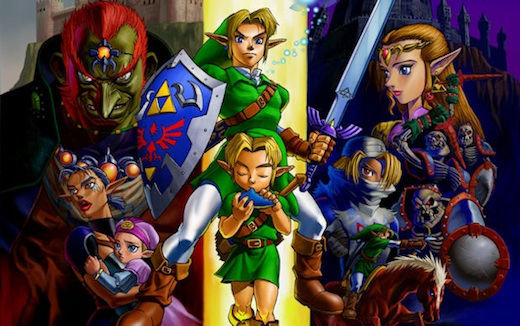
This year marks the 15th anniversary of the release of “The Legend of Zelda: Ocarina of Time.” Critics frequently laud the Nintendo 64 title as the greatest video game ever. To mark the occasion, I will try to examine the classic from a progressive perspective, analyzing its portrayal of class, race, ethnicity, religion, sex, sexual orientation, and species.
Some readers may take criticism of “Ocarina” as dismissal of the game. But this isn’t the case. As Feminist Frequency blogger Anita Sarkeesian says, “Remember that it’s both possible and even necessary to simultaneously enjoy media while also being critical of its more problematic or pernicious aspects.”
Because games’ technological capabilities have increased so rapidly since “Ocarina” was released, I suspect the title’s reputation is somewhat inflated due to nostalgia of critics of a certain age. But it’s a nostalgia I share. There is no game with which I have more fond memories. So criticism here should be interpreted as loyal opposition.
The game’s perspective on class issues perhaps can be seen in its portrayal of the Kakariko carpenters and the wealthy family in the House of Skulltulla.
The relationship between the self-described “boss” of the carpenters and those he calls “my workers,” appears to be one of a guild member and apprentices or journeymen. This is suggested because the boss refers to himself as a master craftsman and states the group was hired by the royal family to improve the village. The preeminent communist Karl Marx described this relationship as one of “oppressor and oppressed,” comparing it to that of “freeman and slave, patrician and plebeian, (and) lord and serf.”
“Ocarina” portrays these apprentices or journeymen as lazy and shiftless, with the boss shown to be the only one willing to work. In short, it’s a complete reversal of reality. Throughout history those who are paid the least tend to be those who work hardest.
“Young men these days don’t have any ambition,” the boss says. “Do you know what I mean, kid? My workers are just running aimlessly around the village, and they’re not making any progress at all… Even my own son doesn’t have a job, and he just wanders around all day! They’re all worthless, I tell you!”
Some may interpret the fate of the wealthy family, who are transformed into spider-like creatures, in the House of Skulltulla as a condemnation of an exploitive class system, but that would be a mistake.
“Folks around here tell of a fabulously rich family that once lived in one of the houses in this village,” an elderly character in Kakariko confides. “But they say that the entire family was cursed due to their greed! Who knows what might happen to those who are consumed by greed.”
By focusing on the greed of individuals, the game ignores how private property incentivizes and even mandates such behavior. And with this moralizing focus comes a belief that society’s economic ills are intractable because of humanity’s admittedly flawed nature.
The racial, ethnic and religious traits of the “good characters” and the “bad characters” within the game imply xenophobia. All of the good characters, such as the Hylians and Kokiri, are white. In contrast, all of the bad characters, such as the thieving Gerudo and their king, Ganondorf, have brown skin. The Gerudo live in the desert, and in case it wasn’t clear what real-life group of people they are based on, the original Gerudo symbol is strongly reminiscent of the Islamic star and crescent.
The title’s perspective on sex is arguably summarized in an advertisement for “Ocarina,” which asks, “Whilst thou get the girl? Or play like one?” The game utilizes a damsel-in-distress trope that suggests women are weak and in need of male protection. Just like every other game in the series, Princess Zelda is incapacitated and in need of rescue from the central character, Link. The repeated use of this sexist cliché helps to, as Sarkeesian says, “normalize extremely toxic, patronizing, and paternalistic attitudes.”
For a portion of the game’s plot, Zelda is represented as an imposing warrior. But, as Sarkeesian points out, she is only able to achieve this disguised as a man and she’s kidnapped within minutes of revealing her true identity.
Sure, Link is also at times injured or captured. At one point, for instance, he’s locked in a Gerudo jail cell. But, as Sarkeesian says, Link, and male protagonists in general, usually get themselves out of the situation. And that ability to overcome obstacles is integral to their development as heroic characters.
Apart from Zelda, who Sarkeesian mentions, Link rescues other female characters who arguably fall into damsel trope, such as Saria, a friend from his Kokiri childhood, and Ruto, princess of the aquatic Zoras.
In addition to reinforcing classist notions, the Kakariko carpenters are exploited for laughter based on their implied sexuality or non-traditional gender performance. Besides running in a stereotypically-feminine style, in the Japanese version of the game made in the developers’ native language, according to ZeldaWiki.org, “All of the carpenters use female first person pronouns like あたし and あたい. They also have a tendency to end their sentences with the particle わ, which is usually only used by women to express emphasis or emotion. (One of the carpenters) also calls Link a “cute boy” when he is rescued.”
The game’s representation of species is best displayed in the idyllic Lon Lon Ranch, a small farm operated by a human father-daughter duo. Entering the location, “Epona’s Song,” a tranquil and nostalgic piece by composer Koji Kondo, plays in the background. The wistful choice in music isn’t surprising, given widespread yearning by industrialized human populations for a recently-abandoned, romanticized pastoralism.
From the perspective of domesticated animals – whose mental capacities could be compared to young, human children and humans with profound mental disabilities – agriculture of the past was a gentler prospect than the modern, factory-farm system. But for non-humans the pre-industrial farm, as symbolized by Lon Lon Ranch, was still a place of exploitation and violence, where their lives, in general, would be significantly shorter and more circumscribed than those of their nearest, wild cousins.
In the game, domestication is portrayed as a mutually beneficial, voluntarily arrangement. The anthropomorphized cows of Hyrule speak to Link, literally saying, “Have some of my refreshing and nutritious milk!” Of course depicting a relationship as anything like symbiotic when one party kills and eats the other, as well as the latter’s children, would be laughable if it wasn’t so appalling.
On this fifteenth anniversary of the game’s release, I encourage readers to dust off their Nintendo 64 and return to Hyrule. Hike up Death Mountain. Swim in Lake Hylia. Explore the Lost Woods. “Ocarina” is a fantastic piece of art we can enjoy while being aware that, like anything else, it’s a product of a particular era and thus influenced by problematic views of the period.










